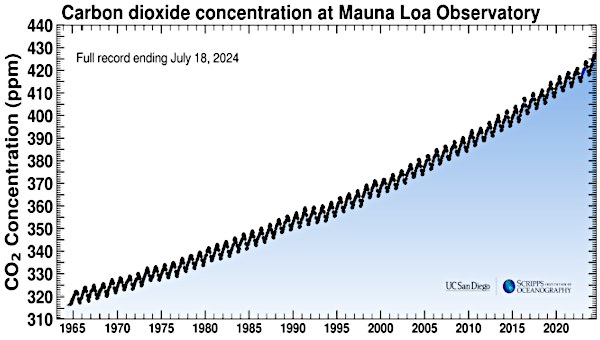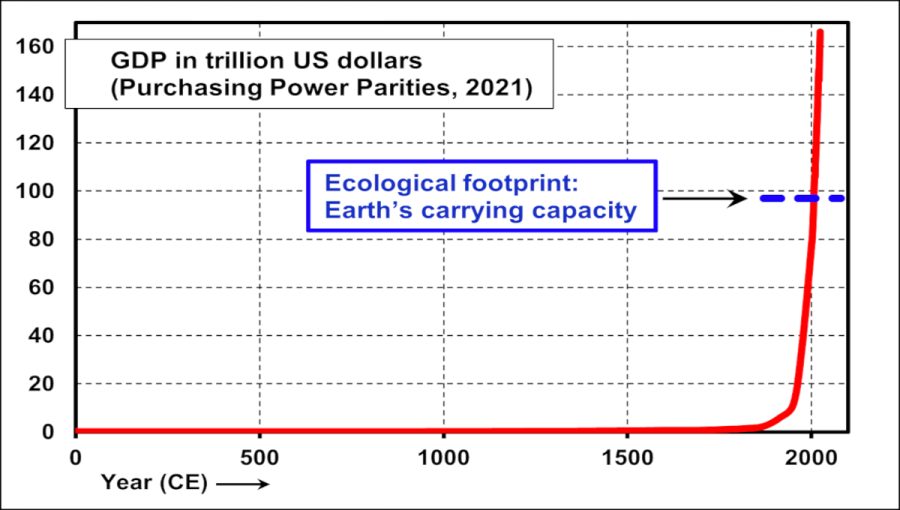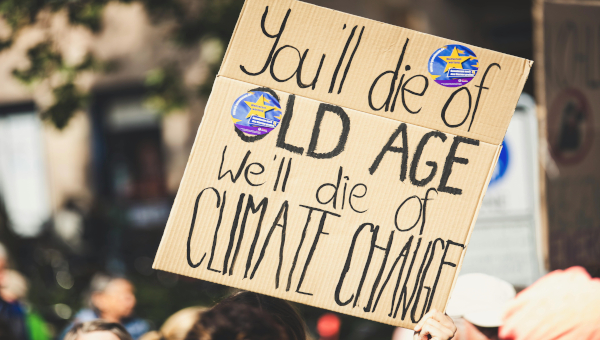Feeling the Heat: Capitalism and Global Warming
We are in real trouble. Global carbon dioxide emissions (the main cause of global warming) continue to rise, hitting a new high in 2023. Last year was also the hottest in recorded history and, year by year, more Americans are feeling the consequences. Yet, we have seen only modest attempts to bring emissions down.
Unfortunately, the US government continues to believe, despite evidence to the contrary, that market forces will encourage a speedy transition away from fossil fuels. Instead, we need to organize in support of direct action to bring down energy use and emissions. We need nothing less than a system-wide transformation of our economy. Consideration of the World War II-era US conversion experience helps to demonstrate both the feasibility of such a transformation and the importance of suppressing market forces to achieve it.

It’s Getting Hotter
Alarm bells are ringing in government circles. As Secretary of Health and Human Services, Xavier Becerra, put it, “Heat is no longer a silent killer, From coast-to-coast, communities are battling to keep people cool, safe, and alive due to the growing impacts of the climate crisis.” According to his agency, there were an estimated 2,302 heat related deaths in 2023, triple the annual average between 2004 and 2018.
However, these totals, which rely on death certificate listings where heat is listed as the main cause of death, are widely believed to be undercounts. One researcher, asked by Miami-Dade County officials to provide a more accurate count of county heat-related deaths, determined that the likely number was at least 10 times the officially published one.
And 2024 is shaping up to be another scorcher. Miami recorded its hottest May on record, with temperatures reaching 112 degrees Fahrenheit. Phoenix experienced its hottest June ever, with temperatures hitting 113 degrees. The Maricopa County heat-related death toll for the month will likely exceed 175 – an 84 percent increase over the previous June.
In fact, much of the country suffered from unusually hot weather. As the Guardian reported in June:
“More than 270 million Americans – about 80 percent of the country’s population – are experiencing a kind of heatwave not seen in decades, smashing records with temperatures at or above 90F (32.2C) for long periods of time under a weather phenomenon known as a heat dome.”
The Pacific Northwest is no exception, with July temperatures soaring over 100 degrees in a number of Oregon cities. As an Oregon Public Broadcasting article pointed out, “The abnormally high temperatures, part of a multiyear warming trend in Oregon, are prompting concerns about health in a state where many homes lack air conditioning.” While temperatures are not expected to reach levels as high as during the 2021 heatwave, when some 600 people died across Oregon, Washington, and western Canada, the threat to human life remains serious because of the expected length of this heat wave.
Excessive heat also takes its toll on workers, greatly increasing the likelihood of serious injury or illness. This is especially true for farmworkers and landscapers; delivery and construction workers; and factory, warehouse, and kitchen workers. Although the Biden administration recently proposed new safety standards to protect workers when temperatures are elevated, business opposition makes its chances of approval unlikely. The governors of Texas and Florida, citing business concerns, each recently signed legislation preventing local governments in their respective states from requiring heat protections for those working outdoors.
As challenging as conditions are becoming in the US, they are far worse in many places in the Global South. Temperatures reached 126 degrees in parts of India and Pakistan. And, as the New York Times explained, “For laborers, not working because of the extreme temperatures can mean not eating.” Air conditioning is a true luxury. In fact, the International Energy Agency reports that more than 750 million people do not even have access to electricity.
Air Conditioning Isn’t the Answer
Many Americans continue to dismiss the dangers from rising temperatures, believing that air conditioning will protect them. However, climate change generates its own challenges to such fixes. A case in point: a major storm hit Houston in May 2024, knocking out power for almost a million households – there was no light and no air-conditioning. The damage to the power infrastructure was so great that even after five days more than 100,000 homes and businesses remained without power. If the storm had struck during a major heat wave, the heat-related death toll could have been considerable.
Recognizing that the number of major blackouts in the United States more than doubled from 2015-16 to 2020-21, several university researchers undertook a study of the probable consequences of a major blackout during a heat wave in three cities: Phoenix, Atlanta, and Detroit. According to a New York Times summary of their results:
“The researchers modeled the health consequences for residents in a two-day, citywide blackout during a heat wave, with electricity gradually restored over the next three days.
“The results were shocking: In Phoenix, about 800,000 people – roughly half the population – would need emergency medical treatment for heatstroke and other illnesses. The flood of people seeking care would overwhelm the city’s hospitals. More than 13,000 people would die.
“Under the same scenario in Atlanta, researchers found there would be 12,540 visits to emergency rooms. Six people would die. In Detroit, which has a higher percentage of older residents and a higher poverty rate than those other cities, 221 people would die.”
The higher death toll in Phoenix was largely due to two factors: the city was likely to suffer a blackout at higher temperatures than the other two cities, and the effects were likely to be greater because a far higher percentage of its population relies on air-conditioning.
Critically, the rise in temperature itself increases the threat of a serious power outage. Warmer weather means more use of air conditioners and greater demand for electricity. Add in the rapidly increasing demand for electricity from tech companies and their data centers, and you have a recipe for a system overload, with transformers exploding and power plants failing. In fact, a 2016 study “found the potential for cascading grid failures across Arizona to increase thirtyfold in response to a 1.8 degree rise in summer temperatures.”
Markets Are Not the Answer
President Biden has touted his administration’s many efforts to reduce US greenhouse gas emissions. At its core, his clean energy strategy can be summarized as follows: electrify as much of the economy as possible, as quickly as possible, using solar and wind power. The Biden administration has used financial incentives and regulatory initiatives to push the economy in the desired direction, but market dynamics – the expected decline in the cost of renewal energy relative to that of fossil fuels – was always expected to be the main driver. That cost crossover happened some five years ago, and the cost advantage of renewables over fossil fuels has only continued to grow. Yet our fossil fuel use has also continued to grow.
US crude oil production set a new record in 2023: the US has produced more oil than any other country in each of the last six years. And although there has been a major expansion in renewable energy production over the last years, the production of fossil fuels for use in electricity generation has also continued to grow, even if at a slower rate. The share of electricity generated by natural gas hit a record high of 42.1 percent in 2023. Coal’s share has been steadily falling, but even at its 2023 low of 16.2 percent, it remains higher than the combination of solar (3.9 percent) and wind (10.2 percent). Rather than replacing fossil fuel use, the increased generation of solar and wind power is largely going to satisfy the steady increase in overall electricity demand.
The main reason that lower solar and wind costs have yet to speed the expected transition away from fossil fuels is that investors don’t find renewable investments sufficiently attractive. As Brett Christophers, a professor of human geography, explains:
“Take the S&P Global Clean Energy Index, which measures the stock performance of leading companies in clean energy, especially solar and wind power. Since the beginning of 2021, this index has lost more than half its value…
“The main cause of this sluggish performance is low profitability. Bluntly stated, clean energy – developing and operating solar and windfarms, and selling the electricity they generate – simply isn’t a very attractive business. Returns are typically in the 5-8 percent range. Compare that with oil and gas production, where returns generally exceed 15 percent, and it is little wonder clean energy stocks have been falling while oil and gas shares outperform.”
Christophers offers several possible explanations for the low returns on renewables. One is that renewable energy production is a very competitive industry, in part because of relatively low barriers to entry compared with fossil fuel production. This market structure tends to drive down returns, and thus, investor interest.
Another is that most developers of renewable energy need outside financial help to cover the upfront costs of building the facilities and transmission infrastructure. And financial institutions are reluctant to provide it because of uncertainty about anticipated costs and revenues. In contrast, fossil fuel companies generally rely on internal funding for their new investments.
Regardless of the reason, the lower costs of solar and wind energy have not encouraged fossil fuel companies to shift their investments from fossil fuels to renewables. It is profitability, not prices, that matter to their CEOs and stockholders, and the profitability of fossil fuels is just too good to pass up, no matter the climate threat. And, as the economist Michael Roberts summarizes, this is not a conclusion that embarrasses them:
“The chief executive of oil producer Chevron told the Financial Times last October, ‘You can build scenarios, but we live in the real world, and have to allocate capital to meet real world demands.’ Four out of five corporate executives considered ‘the ability to create acceptable returns on projects a main barrier to decarbonization of the energy system’.”
“‘We should abandon the fantasy of phasing out oil and gas and, instead, invest in them adequately reflecting realistic demand assumptions,’ says Amin Nasser, chief executive of Saudi Aramco. ‘You can argue green all day and NGOs all day, but those are the facts. I think that message is beginning to resonate,’ said Liam Mallon, head of ExxonMobil’s upstream business.”
It’s Not Too Late to Act
It’s not too late to take meaningful steps to reduce emissions. While most climate scientists believe that it is no longer possible to keep the earth’s average surface temperature from rising above the 1.5C target set by the 2015 Paris Climate Conference, a Guardian survey of climate experts found that the great majority believe that “1.5C was not a cliff-edge leading to a significant change in climate damage. Instead, the climate crisis increases incrementally, meaning every ton of CO2 avoided reduces people’s suffering.”
How bad might it get? According to what the experts told the Guardian, if we allow the temperature to rise to 2.7C: “Two billion people would be pushed outside humanity’s ‘climate niche,’ i.e., the benign conditions in which the whole of civilization arose over the past 10,000 years.” At 3C: Cities including Shanghai, Rio de Janeiro, Miami, and the Hague would end up below sea level. At 3C and above: “The impact of climate shocks in one place will cascade around the world, through food price spikes, food and water shortages, broken supply chains, and refugees by the millions.” As to current trends, according to the UN climate chief, speaking at the June 2024 meeting of the International Energy Agency, the planet is on track for a “ruinously high” 2.7C rise in the global temperature over that of the pre-industrial era.

Clearly, we need to act quickly to bring down emissions. And that means radically transforming the way we live and work. The starting point for such a transformation must be a reduction in the exploration, production, and use of fossil fuels in favor of clean energy sources like solar and wind. However, given the need to reduce overall emissions and resource exploitation, we cannot aim for a simple one-to-one replacement of energy sources. As beneficial as they may be, renewable energy sources also depend on critical raw materials that are limited in supply and their extraction from the earth creates its own ecological problems, especially for those in the Global South.
Limiting our overall energy use (and emissions) in a way that protects the interest of working people means that we must also take steps to reduce the production of ecologically destructive and socially less necessary goods and services, including single-family mansions, giant sport utility vehicles, private jets, luxury cruises, fast fashion, industrially produced meat and dairy, single use/disposable products, and the like. And because the Department of Defense is, in the words of Neta C. Crawford, Co-Director of the Costs of War project at Brown and Boston Universities, “the world’s largest institutional user of petroleum and correspondingly, the single largest producer of greenhouse gases in the world,” substantial energy savings can also be achieved from reducing our military budget and global infrastructure for the projection of power.
With a sizeable reduction in energy use from the actions highlighted above, a newly expanded clean energy sector should be able to support, at a lower level of overall energy use, a significant expansion in a number of socially beneficial goods and services. Examples include a well-funded national health care system, universal education system, and accessible and affordable program of public housing; an expanded system of affordable public transportation; and support for regenerative agricultural practices. The job creation from such programs will be substantial.
After decades of unchallenged neoliberal policies, many people will understandably find it hard to imagine how such a transformation could be achieved. And the challenges and tasks will be many. Some new industries will have to be rapidly developed and the productive capacities of some existing ones expanded. We will need to create agencies capable of deciding the speed of growth as well as ownership of the new facilities, how the new investments will be financed, and how best to ensure that the materials required will be produced in sufficient quantities and made available to the designated enterprises at the appropriate time.
We will also have to develop mechanisms for deciding where new establishments will be located and how to provide the social infrastructure to house and care for the required workforce. And we will need to develop programs that will ensure that newly hired workers receive appropriate training. In sum, a system-wide transformation involves a lot of moving parts that must be managed and coordinated.
To help, we have the World War II conversion experience to demonstrate the feasibility of such a transformation. Despite the many differences in times and aims, there are some significant similarities in the challenges planners faced then and ones we are likely to face now. Most importantly, then as now, there was an urgent need for a system-wide economic conversion, a conversion resisted by many of the country’s most powerful corporations.
Corporations producing goods of direct importance to the war effort – for example, those producing aluminum and steel – refused to undertake needed investments. Overall private investment fell in value over the years 1941 to 1943. That last year, business investment was only 37 percent of its 1940 level. At the same time, corporations producing consumer goods – most importantly, those producing automobiles – routinely ignored government entreaties to curtail or convert their production to economize on the nonmilitary use of scarce materials.
The US government succeeded in transforming the economy from civilian to military production, converting it into the celebrated “arsenal of democracy,” only because it undertook the required spending, investing, and planning itself. Military spending as a share of GDP rose from 1.6 percent in 1940 to 36.0 percent in 1944. As a result, the combined output of the war-related manufacturing, mining, and construction industries doubled between 1939 and 1944. In that last year, federal purchases of goods for the military accounted for approximately one-half of all goods produced.
The economy was able to respond to the explosion in military spending because the government pursued an active and aggressive policy of targeted investment. A May 1940 act led to the creation of the Defense Production Corporation (DPC), which was given a blank check to finance the expansion of facilities deemed critical to the war mobilization. The DPC kept ownership of the new facilities it financed but planned the construction with predetermined companies who were then allowed to manage them.
The DPC alone financed and owned some one-third of all the plants and equipment built during the war. At its termination in June 1945, the DPC:
“owned approximately 96 per cent of the capacity of the synthetic-rubber industry, 90 per cent of magnesium metal, 71 per cent of aircraft and aircraft engines, and 58 per cent of the aluminum metal industry. It also had sizeable investments in iron and steel, aviation gasoline, ordnance, machinery and machine tools, transportation, radio, and other more miscellaneous facilities.”
The successful conversion also required detailed planning. For example, newly created government agencies worked to free resources for war production by selectively ordering the curtailment or outright suppression of production by many civilian industries. As a result, between 1940 and 1944, the total production of nonmilitary goods and services fell by more than 10 percent.
Other agencies were created to ensure an efficient allocation of resources. During the first years of the fighting, the military’s demand for goods and services outpaced the economy’s ability to meet it. The result was a shortage of key materials and components, inflation, and disrupted production. Order was established only when planning agencies began directly allocating the existing stock of critical metals and components among key producers, eventually forcing the military to bring its plans in line with the economy’s capacity to produce. Still other agencies were empowered to determine the location of the new government owned plants and to finance the construction of the housing, day care programs, and urban infrastructure needed to house and support the growing workforce in the selected locations.

And despite government efforts to win corporations to the war effort, which included allowing high profit margins on government contracts and a willingness to appoint business representatives to key positions in planning agencies, corporate leaders remained critical of the government’s expanded role in the economy throughout the war. In fact, many questioned whether the cost of victory was too high. As the economist J.W. Mason describes,
“J. Howard Pew of Sun Oil declared that if the United States abandoned private ownership and ‘supinely reli[es] on government control and operation, then Hitlerism wins even though Hitler himself be defeated.’ Even the largest recipients of military contracts regarded the wartime state with hostility. GM [chair] Alfred Sloan – referring to the danger of government enterprises operating after war – wondered if it is ‘not as essential to win the peace, in an economic sense, as it is to win the war, in a military sense,’ while GE’s Philip Reed vowed to ‘oppose any project or program that will weaken’ free enterprise.”
The wartime conversion of the US economy was a tumultuous affair, with many mistakes made. Yet, for all that, government policy succeeded in orchestrating a rapid transformation of the economy, one that enabled the US to play a pivotal role in the eventual Allied victory. Tragically, and perhaps not surprisingly, corporate leaders were able to use their structural power to ensure that the economic changes made during the war were quickly undone: government-owned factories were sold off at bargain prices to the companies selected to run them, and planning agencies were disbanded as quickly as possible after the end of the fighting.
There is much we can learn from this wartime conversion experience. Among other things, it demonstrates the feasibility of a rapid, system-wide conversion of the US economy. It also shows the critical role of state planning, public financing and ownership, and state direction of economic activity in achieving such a conversion. And it highlights the resistance that a conversion process can be expected to generate from business leaders.
But having confidence that a transformation can be achieved is not the same as having the political strength to achieve it. And we face enormous challenges in building the movement we need. Among them: weakened unions, popular distrust of the effectiveness of public planning and ownership, and weak ties among labor, environmental, and other key community organizations. Overcoming these challenges will require sustained conversations and organizing to strengthen the capacities of and the connections among our organizations and to develop a shared and grounded vision of the changes we desperately need to make. •
This article first published on the Reports from the Economic Front website.





